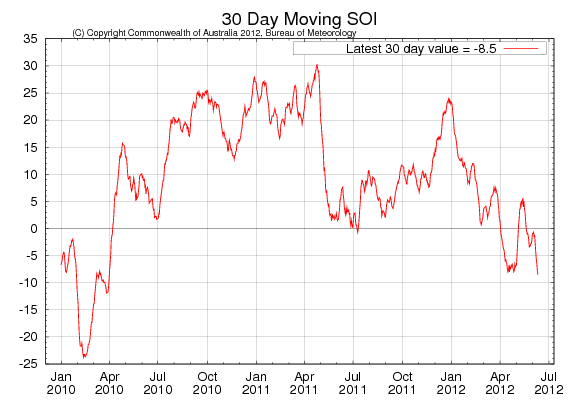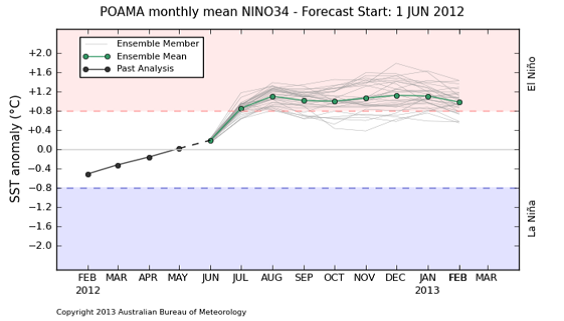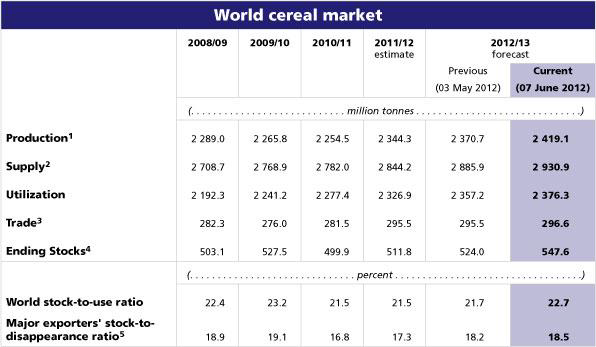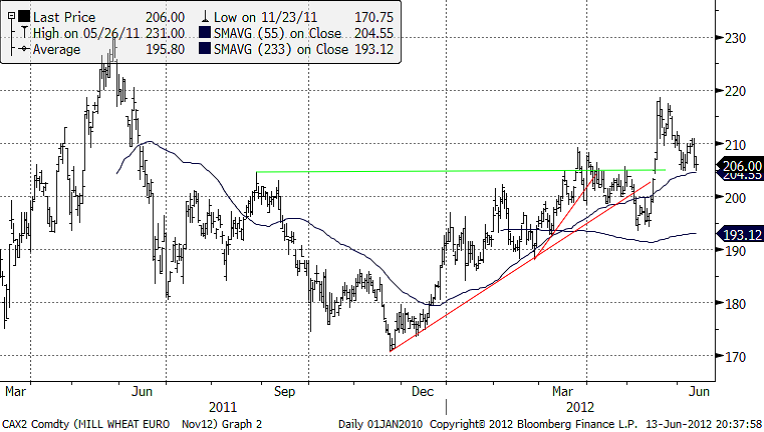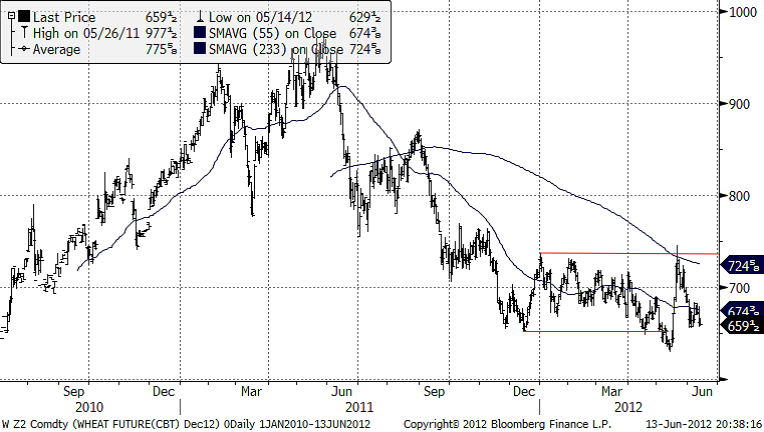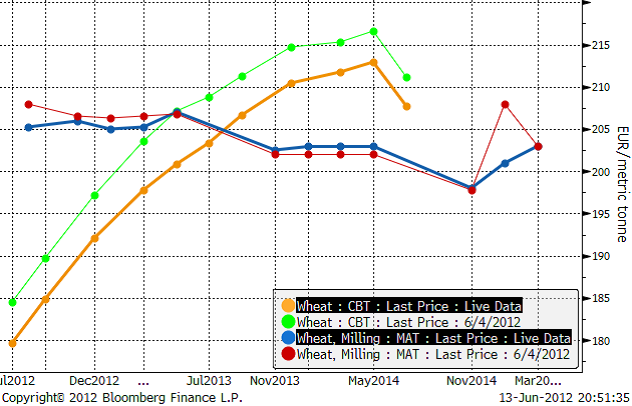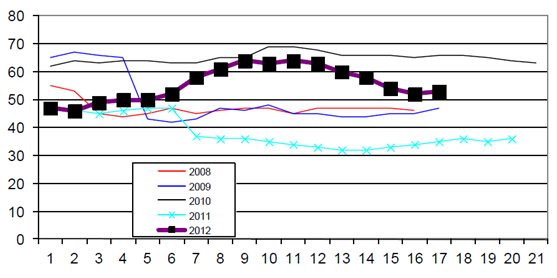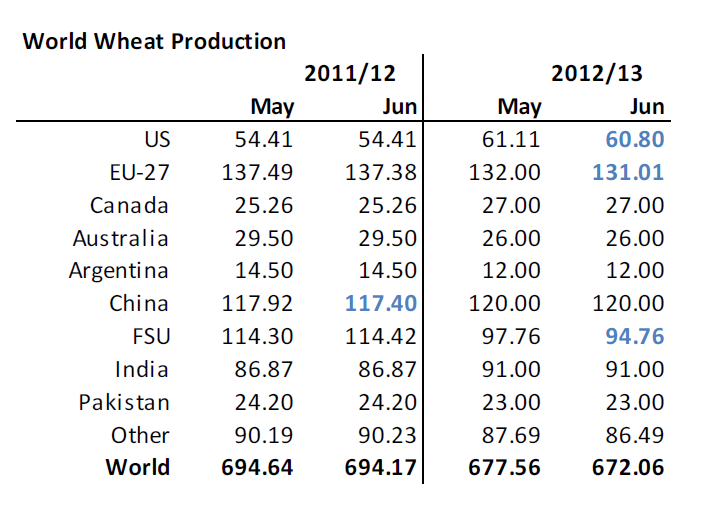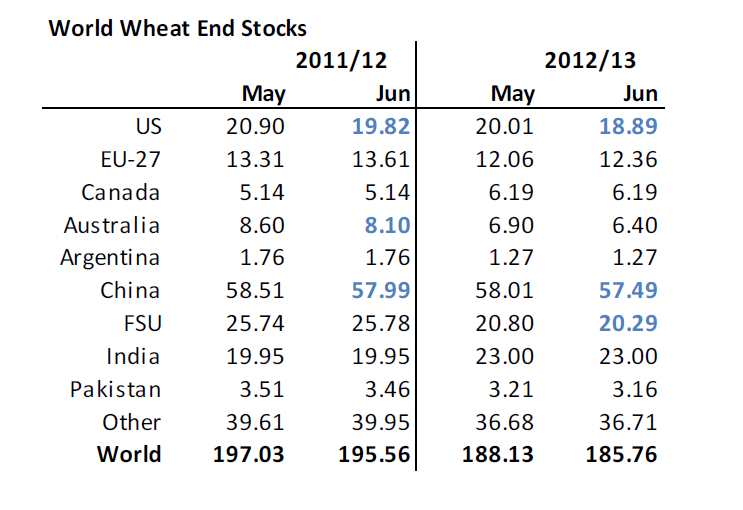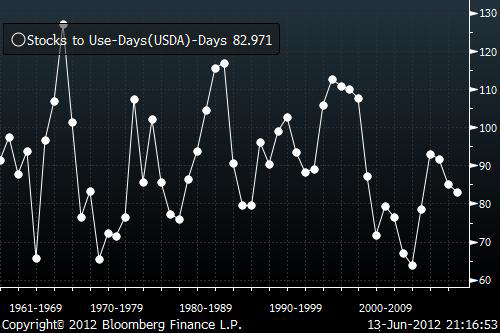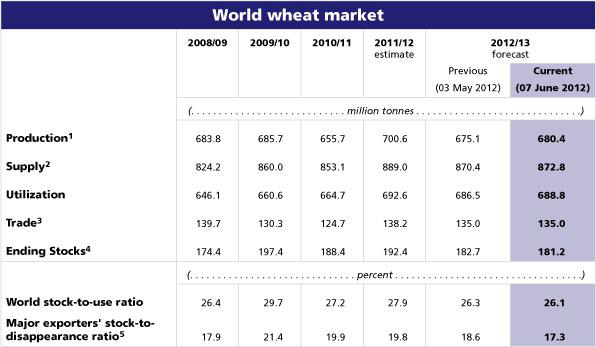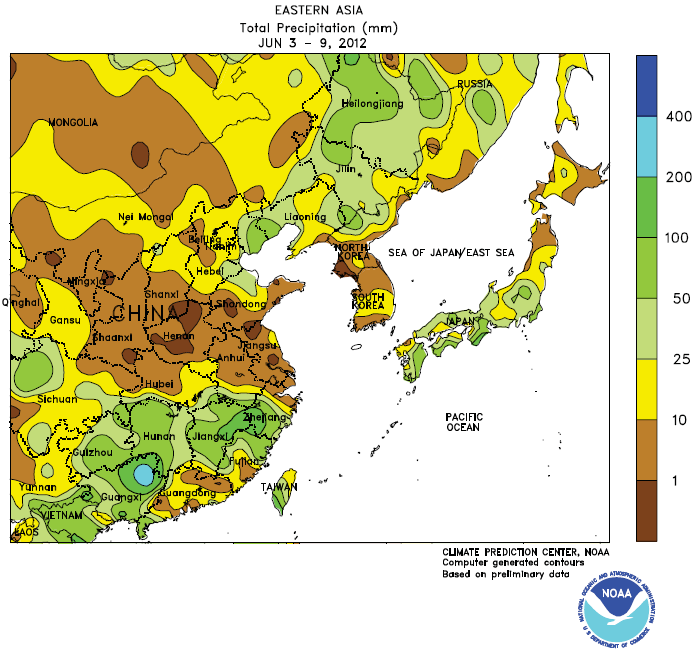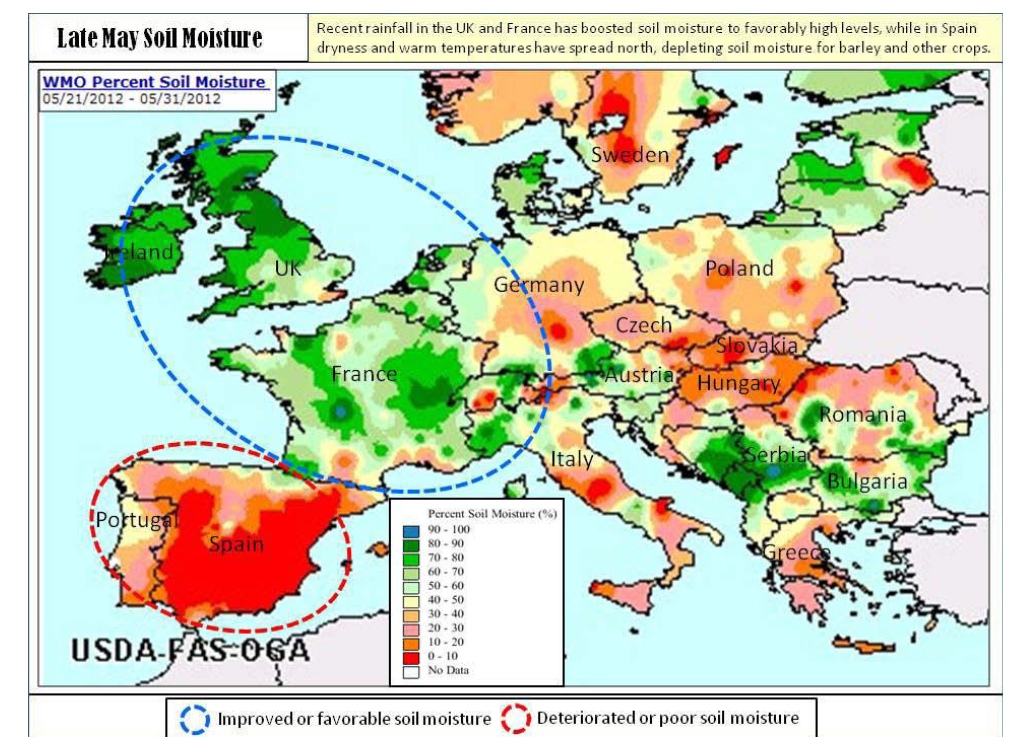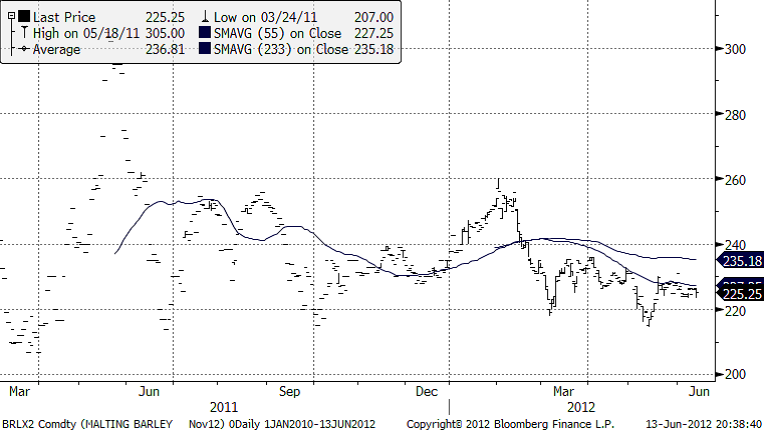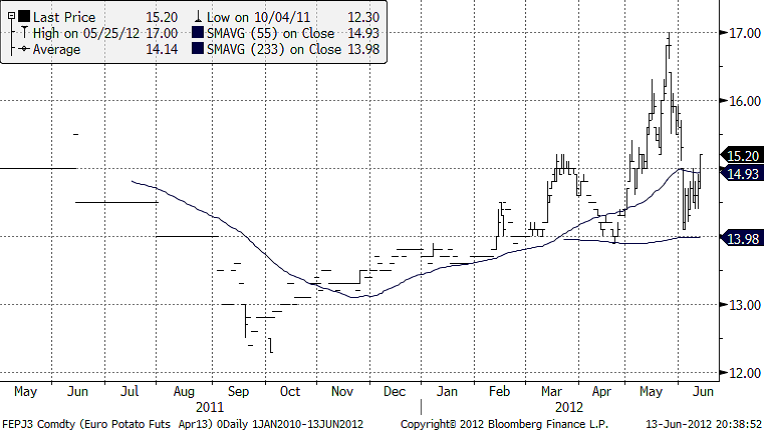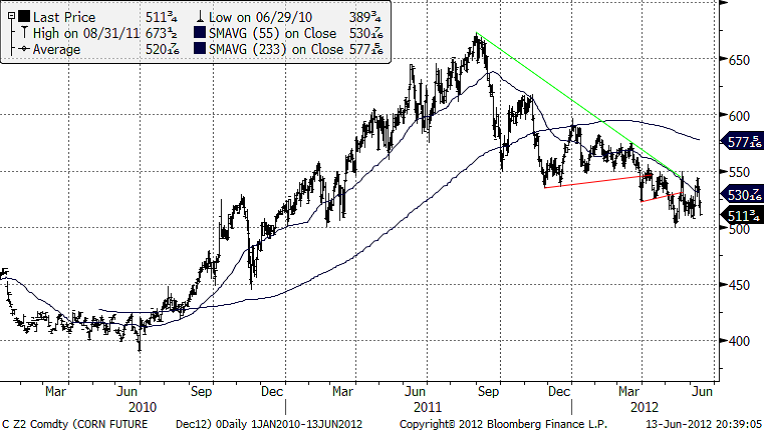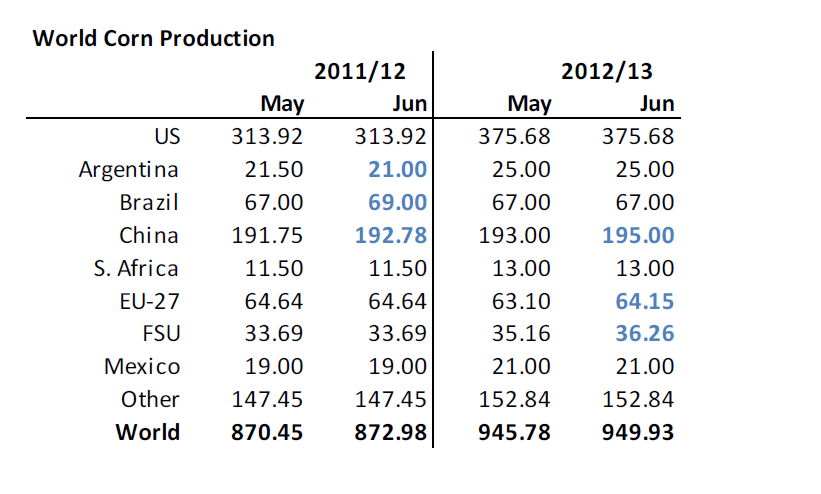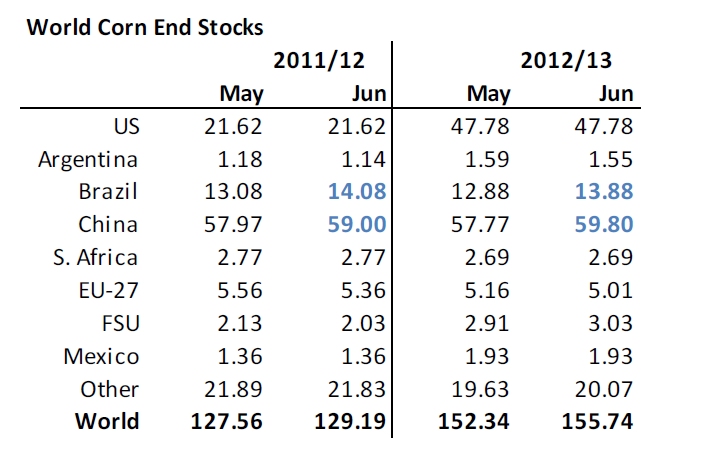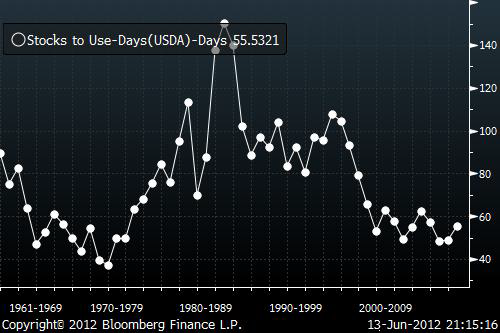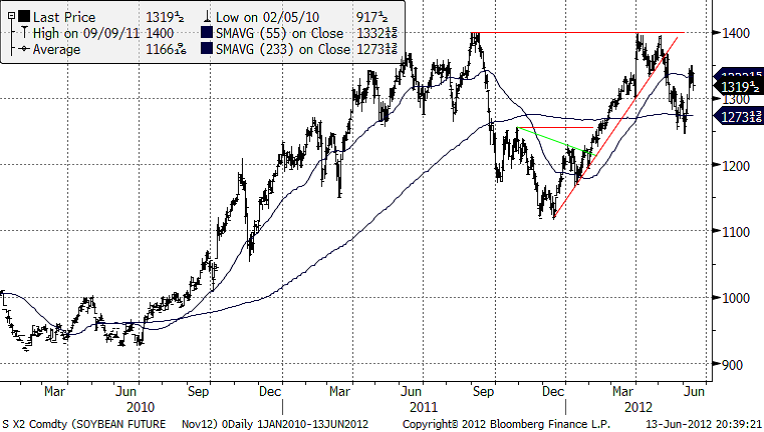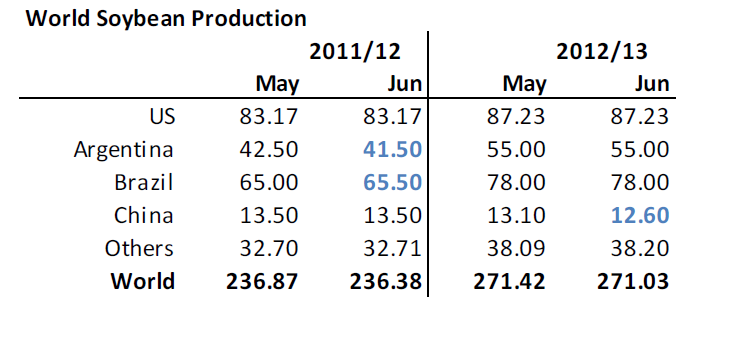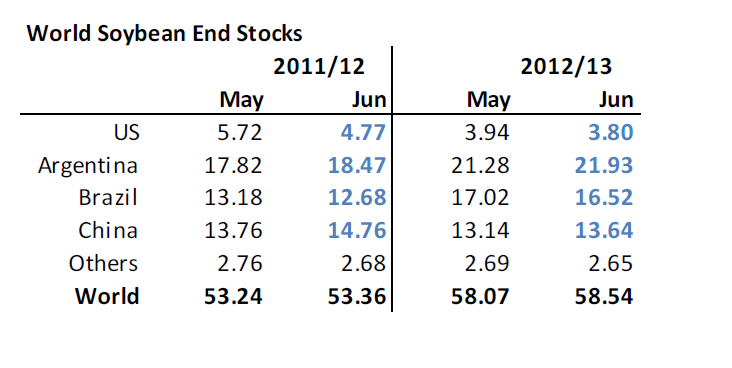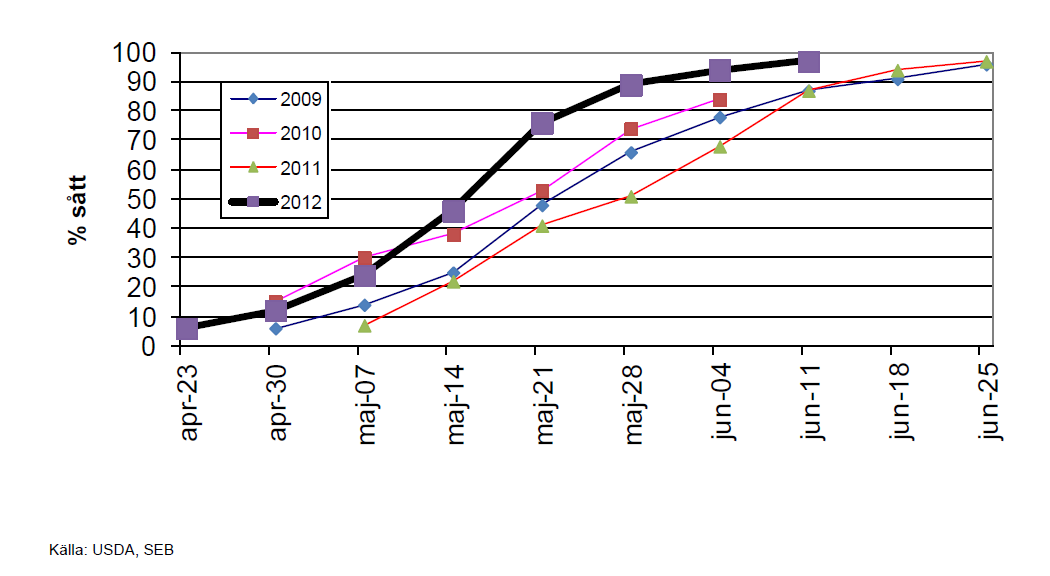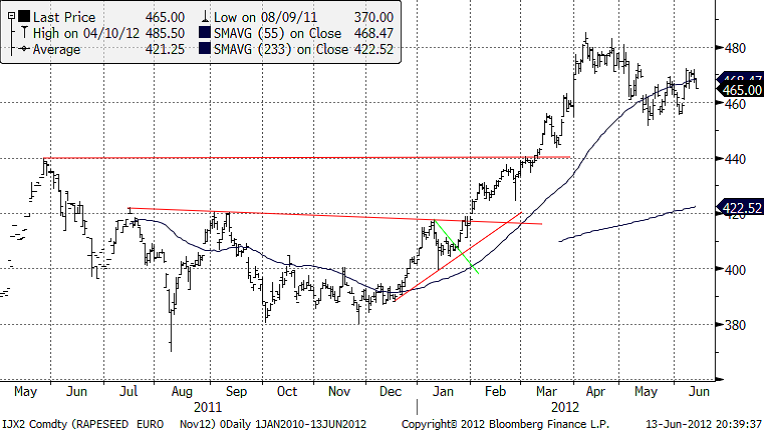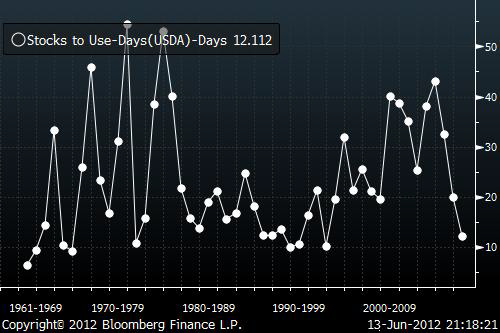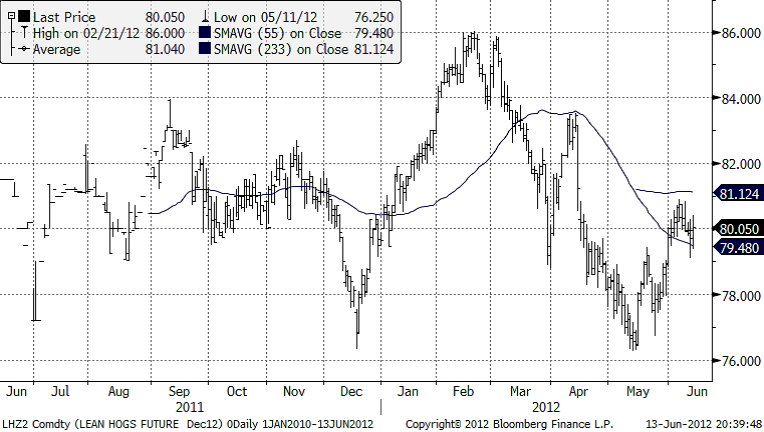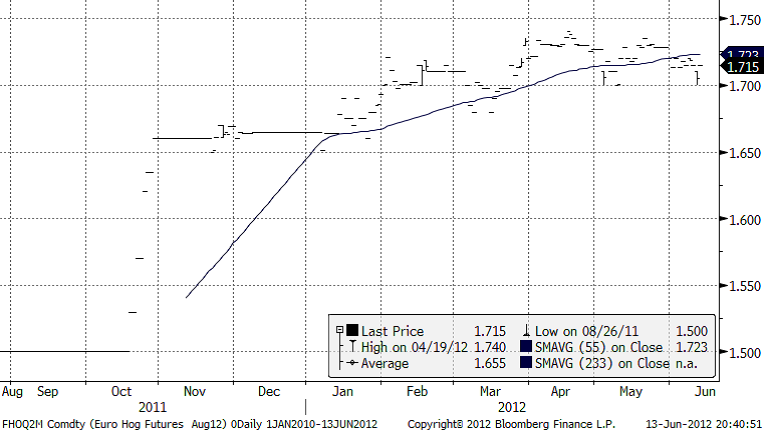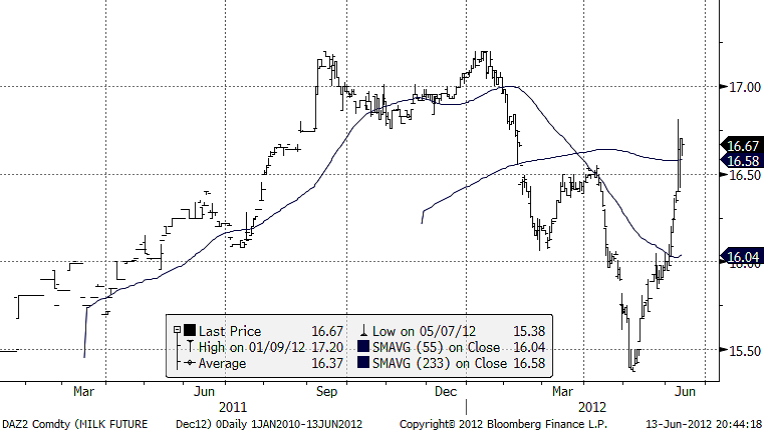Analys
SEB – Jordbruksprodukter, vecka 24 2012
 Kullagertillverkaren SKF:s vinstvarning under onsdagen är ett tecken i tiden på att efterfrågan på sällanköpsvaror har bromsat in. Vi får signaler om att konsumenterna är i samma sinnesstämning som sommaren 2008 – dvs man avhåller sig från större investeringar. Kinas ekonomi bromsar. Indiens bromsar. Europa är i kaos och Greklands nyval äger rum i helgen, den 17 juni, vilket knappast kommer att lösa några problem.
Kullagertillverkaren SKF:s vinstvarning under onsdagen är ett tecken i tiden på att efterfrågan på sällanköpsvaror har bromsat in. Vi får signaler om att konsumenterna är i samma sinnesstämning som sommaren 2008 – dvs man avhåller sig från större investeringar. Kinas ekonomi bromsar. Indiens bromsar. Europa är i kaos och Greklands nyval äger rum i helgen, den 17 juni, vilket knappast kommer att lösa några problem.
EU kommer att införa positionslimiter för europeiska aktörer i råvaruterminsmarknaden i Mifid 2, som träder i kraft år 2015. Eftersom alla slutkunder handlar råvaruterminer OTC med banken, dvs med banken som motpart, och banken sedan handlar på börsen, kan detta 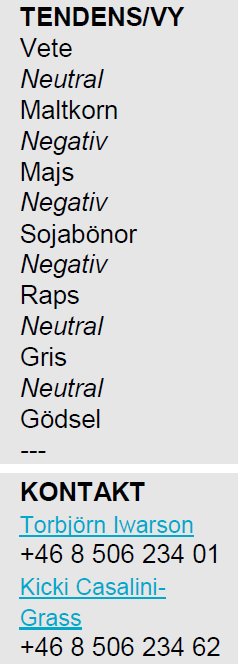 leda till att kunderna inte kan handla. Intresset hos EU att lyssna på dem som påpekar detta för dem är lika med noll. EU:s syfte med dessa positionslimiter är att undvika möjligheten till manipulation av priser, men det finns inga vetenskapliga bevis för att man åstadkommer detta. Det är också så klart helt obegripligt hur de tror att man kan skydda marknaden mot manipulation utan att reglera den fysiska varumarknaden.
leda till att kunderna inte kan handla. Intresset hos EU att lyssna på dem som påpekar detta för dem är lika med noll. EU:s syfte med dessa positionslimiter är att undvika möjligheten till manipulation av priser, men det finns inga vetenskapliga bevis för att man åstadkommer detta. Det är också så klart helt obegripligt hur de tror att man kan skydda marknaden mot manipulation utan att reglera den fysiska varumarknaden.
Det verkar också som om det kommer att införas en omsättningsskatt på terminsaffärer inom EU, vilket ökar transaktionskostnaden för att prissäkra jordbruksprodukter. Sverige och Storbritannien har hittills varit ovilliga att gå med på detta, som naturligtvis gör det dyrare att prissäkra bort prisrisk för jordbrukssektorn.
USDA har släppt juni månads upplaga av sina WASDE-estimat för produktion, konsumtion och därmed utgående lager. Det var inga större överraskningar. Möjligen var överraskningen att man inte justerade hektarskördens storlek alls i USA, som ju haft lite mer torka än man räknat med.
FAO har också uppdaterat sina prognoser och de är klart negativa för framtida prisutveckling.
Odlingsväder
Southern Oscillation Index, ett mått på intensiteten i graden av La Niña eller El Niño, sjunkit lägre. Aktuell notering är -8.5. Ett värde lägre än -8 innebär El Niño. El Niño är bra för globalt odlingsväder.
Nedan ser vi ensembleprognosen för ENSO med basdatum den 1 juni. Som vi nämnt ovan, ser vi att ingen av modellerna ens hamnar nära nollstrecket, än mindre en återgång till La Niña. Istället är den här uppdaterade körningen tydligare än i maj, att El Niño kan uppstå redan i juli.
El Niño betyder ökad nederbörd i Sydamerika och i Nordamerika och mindre i Australien och i Sydostasien.
Global spannmålsproduktion
Den totala spannmålsproduktionen i världen 2012 beräknas nu uppgå till rekordhöga 2 419 mt efter att FN:s livsmedels- och jordbruksorganisation (FAO) höjer sin prognos för produktionen med 48,5 miljoner, vilket är 3,2 procent upp jämfört med 2011. Ökningen beror främst på en förväntad rekordskörd av majs i USA.
Utifrån de senaste estimaten skulle den globala spannmålsproduktion överstiga den förväntade användningen för 2012/13, som har justerats upp med 19 mt sedan förra månaden, och leda till en rejäl påfyllnad av världens spannmålslager med 36 mt, eller 7 procent, jämfört med 2011/12.
Vete
Matifvetet med novemberleverans föll tillbaka efter WASDE-rapporten. Tekniskt ligger priset på en nivå där det finns stöd. 206 euro är alltså en viktig nivå, liksom förstås 200 euro på en lägre nivå. Vi har en negativ grundsyn på prisutvecklingen och är hellre säljare än köpare. Detta av två anledningar: att efterfrågan i den globala ekonomin bromsar in och att ENSO förutspås gå in i El Niño, som är gynnsamt för produktionen.
Nedan ser vi Chicagovetet med leverans i december. Priset ligger i den nedre delen av det prisintervall som vetet handlats till sedan december förra året. Det lär locka fram en del köpare, men det kan också innebära en ny fara för att priset bryter ner under intervallet. Men vi måste komma ihåg att decembervete i Chicago nu är mycket billigare än vetet på Matif.
Nedan ser vi hur terminspriserna på Matif och Chicago förändrats den senaste veckan. Matif är oförändrad. Chicago har fallit över alla terminslöptider. Vi är hellre säljare av Matif än av Chicago, i synnerhet vad gäller december 2012, där Chicago ligger på lite drygt 190 euro per ton. Möjligen kan man våga sig på att köpa Chicago december och sälja Matif november i förhoppning om att priserna ska konvergera.
Crop condition för höstvetet i USA, som rapporterades i måndags kväll klockan 22, ligger på 53% good / excellent, vilket är 1% högre än förra veckan.
I WASDE-rapporten justerades produktionen ner med 5 mt för 2012/13.
Nedan ser vi utgående lager, som justeras ner med drygt 2 mt. Global konsumtion minskas med nästan lika mycket som produktionen. Med ett något lägre pris, verkar det kanske lite märkligt att efterfrågan ska minska jämfört med förra månaden. Det är ju inte utbudet, utan priset som normalt ransonerar efterfrågan.
Nedan ser vi ett diagram på utgående lager, uttryckt som antal dagars konsumtion. Vi ser att globala utgående lager är på en relativt låg nivå, och alltså inte väntas stiga 2012/13. Det innebär att potentialen för radikalt lägre priser är begränsad. Det innebär också att priserna kommer att vara svängiga då konsumenter är lite extra oroliga.
FAO:s prognos för den globala produktionen av vete 2012/13 visar en nedjustering från förra säsongen till 680 mt, vilket dock är 5 mt högre än tidigare prognos och fortfarande en bra bit över genomsnittet de senaste fem åren.
Vetearealen och produktionen i Kina 2012/13 förväntas bli oförändrad. I provinserna Henan, Hebei, Anhui, Shandong och Jiangsu, som är de stora producenterna av höstvete, börjar skörden i juni (vissa sydliga provinser har redan startat). Även om torka har rapporterats i Hebei-provinsen, är det dock fortfarande för tidigt att säga om detta kommer att påverka produktionen.
Importen av vete 2011/12 estimeras till 3 mt då importerat vete, särskilt från Australien, är relativt konkurrenskraftigt, jämfört med det inhemska vetet, till både foder och mjöl i de kustnära provinserna.
Importen av vete under 2012/13 förväntas vara fortsatt stark i spåren av fortsatt konkurrenskraftiga priser.
Prognoserna för Rysslands spannmålsskörd 2012 varierar från ett lägsta om 88 mt från vissa branschanalytiker till så högt som 93-94 mt av det ryska jordbruksministeriet. FAS estimerar produktionen till 88 mt, en nedgång från 94 mt förra året, som en följd av dåliga förhållanden för övervintring i de viktiga södra produktionsområdena samt torrt och varmt vårväder i Volga området och i de centrala delarna. I många delar var höstgrödorna i mycket gott skick i mars och början av april, men sedan dess har förväntningarna på avkastning sänkts på grund av en drastisk och oväntad minsknings av markfuktighet. Många lantbrukare har klagat över att det praktiskt taget inte blev någon vår, då den kalla vintern plötsligt byttes ut mot sommarvärme och torka, vilket resulterade i att de varma temperaturerna snabbt smälte snön som snarare avdunstade istället för att tillföra jorden behövlig fukt.
I mitten av maj uppskattades Rysslands höstgrödor att vara i sämre skick än under 2011, men fortfarande i närheten av det femåriga genomsnittet.
USDA estimerar Rysslands vete produktion 2012/13 till 53 mt, en minskning med 3 mt jämfört med förra månaden och ned 3.2 mt från förra året, och som beror på det varma och torra vädret i den europeiska delen av Ryssland. Ihållande torka och varma temperaturer under april och större delen av maj hämmade grödornas utveckling i Rysslands södra distrikt, som står för ca hälften av landets produktion av höstvete. Arealen beräknas uppgå till 25.5 miljoner hektar, oförändrad från förra månaden, och avkastningen estimeras till 2.08 ton per hektar, en minskning med 8 procent från förra året och 6 procent under det femåriga genomsnittet.
Fru Martell är dock lite mera skeptisk och säger att den exceptionella vårvärmen i Ukraina och Ryssland kan ha orsakat mer skador och ett större bortfall än vad som anges av USDA i senaste WASDE-rapporten.
USDA uppskattar produktionen av vete i EU-27 till 131 mt, en minskning med 1 mt från förra månaden och ned 6.4 mt jämfört med förra året. Arealen estimeras till 24.6 miljoner hektar, en minskning med 0.3 miljoner från förra månaden och avkastningen beräknas till 5.32 ton per hektar, jämfört med förra månadens 5.30 t/ha och förra årets 5.36 t/ha.
Ogynnsamma förhållanden har präglat Centraleuropa under stora delar av växtsäsongen med torka under hösten, köldknäppar under vintern och återigen torka under tidig vår. Torftig utveckling i kombination med utvintring har lett till bortfall av höstgrödor, som kommer att ersättas med vårgrödor, vilket resulterar i lägre avkastning.
De redan låga prognoserna för tyska och polska grödor justeras ned ytterligare i denna månads rapport och reflekterar den senaste tidens väderrelaterade skador. Produktionen i Tyskland justeras ned 0.7 mt till 21.8 mt medan produktionen i Polen beräknas till 8.1 mt jämfört med 9.3 mt förra året. För Frankrike, Europas största vete producent, justeras prognosen upp med 0.5 mt från förra månaden till 37 mt som en följd av gynnsamma (blöta) väderförhållanden.
Maltkorn
Novemberkontraktet på maltkorn har fortsatt att handlas sidledes, något svagt. 220 euro tycks vara ett psykologiskt stöd för marknaden.
Potatis
Potatispriset för leverans nästa år, som i slutet av maj var uppe på 17 euro per deciton och sedan såldes ner till 14, har återigen vänt uppåt. Trenden är alltjämt uppåtriktad och vi fortsätter att ha en positiv syn på potatispriset för ny skörd.
Majs
Priset på decembermajs fortsätter i sin negativa trend, som marknaden haft sedan september förra året. Vi tror att majspriset kommer att bryta 500 cent och fortsätta ner. 500 cent är en psykologiskt viktig nivå, inte minst för att det är en så jämn siffra. Jämna siffror brukar attrahera köpordrar av folk som inte tänker längre än så.
Nedan ser vi WASDE-rapporten för majsproduktionen. Vi ser att produktionsestimatet för 2012/13 höjs med 4 mt. Det kanske märkligaste är att man inte justerat hektarskörden i USA, som varit torkdrabbat hittills. För vårens skörd, 2011/12, justerades Brasilien upp till 69 mt.
Nedan ser vi USDAs estimat för utgående majslager. Dessa väntas öka 2012/13, med drygt 3 mt. Detta innebar att marknaden tog rapporten negativt.
Lagren av majs har länge varit låga, men nu väntas alltså högre utgående lager, som ser i nedanstående diagram. Diagrammet visar utgående lager i termer av dagar av konsumtion sedan 1961. Efterfrågan från Kina och andra tillväxtländer och efterfrågan på råvara till etanoltillverkning har hållit lagren pressade. När det gäller etanol är ökningen i efterfrågan med största sannolikhet över. I USA har man nått upp till 10% inblandning och högre går inte att gå utan skador på motorerna. Naturgas har blivit ett extremt billigt bränsle i USA och kommer troligtvis att ta marknadsandelar både på bensinens och därmed också etanolens bekostnad.
Sådden i USA var klar för en månad sedan. USDA har slutat publicera siffror på sådden.
Majsproduktionen i Kina 2012/13 beräknas vara relativt oförändrad från förra året. På grund av lägre vinstmarginaler för sojabönor och bomull i nordost och nordkinesiska slätten, förväntas lantbrukarna att öka majsarealen med 2 procent.
Importen av majs 2011/12 estimeras till 5.5 mt, även om ytterligare inköp av staten kan bli möjliga om priserna på importerad majs håller sig konkurrenskraftiga. Importen under 2012/13 beräknas uppgå till 7 mt på förväntningar om att en stark inhemsk efterfrågan från industri och djuruppfödning kommer att hålla de inhemska majspriserna relativt sett högre än priserna på importerad majs. Flera källor inom industrin säger att de höga majspriserna under säsongen 2011/12 delvis beror på dålig kvalitet i provinserna Hebei, Henan och Shandong, vilket därmed har begränsat utbudet. Förhöjda toxinhalter gör majsen oanvändbar och i mars 2012 uppskattade CNGOIC att ca 5 mt majs innehöll gifter som aflatoxin.
Även om Rysslands veteproduktion fick se en nedjustering av USDA så ser det betydligt bättre ut för landets majsproduktion. USDA justerar upp sin prognos för 2012/13 till 7.8 mt, en ökning med 0.8 mt från förra månaden och upp 1.1 mt från förra året. Den beräknade produktionen slår därmed det tidigare rekordet på 6.7 mt som sattes 2008/09 och som matchades 2011/12. En ökning i areal med 23 procent på årsbasis är den bidragande orsaken och beror på en kombination av högre inhemsk konsumtion av majs som foder, ökad bearbetning av förädlade produkter som gluten och majssirap, och bortfall av höstraps och korn i södra Ryssland som kommer att ersättas.
Sojabönor
Lägre ekonomisk tillväxt runtom i världen tynger sojabönorna. Vi ser ett lite längre prisdiagram på novemberkontraktet nedan. Så länge det inte blir någon störning av höstens sådd i Sydamerika bör priset kunna hålla sig under 1400 cent. Vi tycker att man ska vara såld sojabönor nu, med stop-loss på drygt 1400 cent. Det finns goda möjligheter till lägre priser framöver.
Nedan ser vi WASDE-rapportens produktionsestimat. Det är inga större förändringar för innevarande år, dock en liten uppjustering av Brasiliens skörd och en lika stor nedjustering av Argentinas. För 2012/13 justerades endast Kinas produktion nedåt.
Utgående lager ser vi nedan. Det är otroligt låga utgående lagerestimat för USA. Globalt är dock lagren på en hyggligt bra nivå.
Nedan ser vi nuvarande utgående lager i historiens perspektiv. Lager som räcker i 59 dagar är en relativt hög nivå, trots allt.
Sådden är till 97% klar i USA, dvs den är klar. Det är rekordtidigt.
Raps
Priset på novemberterminen befinner sig fortfarande i rekyl efter vårens kraftiga prisuppgång. Det är större brist på raps än på sojabönor och rapsen är mindre beroende av Kinas efterfrågan.
USDA publicerar även globala estimat på utgående lager för rapsfrö. USDA:s senaste prognos för den globala produktionen av raps är oförändrad från förra månaden på 60.43 mt. Estimatet för produktionen i EU-27 har justerats ned med 0.10 mt (Polen / Ungern) medan produktionen i Ryssland har justerats upp med samma mängd.
första prognosen från Frankrikes jordbruksministerium för 2012 års skörd visar på en 10-procentig minskning för höstrapsen som en följd av den extrema kylan tidigare i år.
Till skillnad från sojabönor är efterfrågan större än produktionen, vilket får till följd att utgående lager minskar. Så har det varit i flera år och det förklarar också styrkan i marknaden för rapsfrö.
Priset måste upp för att stimulera mer produktion, eller ransonera konsumtionen. Globala lager som innan skörd räcker för 12 dagars konsumtion är en mycket låg nivå.
Låga lager innebär att marknaden är oroligare än annars. Prisrörligheten kommer att vara hög.
Gris
Decemberkontraktet har fallit tillbaka 1 cent sedan förra veckan i avvaktande handel.
Nedan ser vi augustikontraktet på hogs på Eurex. Det är 78 kontrakt öppen balans, dvs det är totalt 78 köpta och sålda kontrakt som clearas av Eurex. Jämfört med för ett år sedan är öppen balans högre och stabilare. Marknaden har av allt att döma fått ett visst förtroende i branschen. Det är naturligtvis långt att gå innan likviditeten är så hög som på CME, men så här långt ser det bra ut.
Mjölk
Mjölkpriset har fortsatt att rekylera uppåt för decemberleverans. 16 cent passerades snabbt, liksom 16.50. Det är en lite väl snabb omvärdering och den euforiska uppgången borde vända till motsatsen inom kort.
[box]SEB Veckobrev Jordbruksprodukter är producerat av SEB Merchant Banking och publiceras i samarbete och med tillstånd på Råvarumarknaden.se[/box]
Disclaimer
The information in this document has been compiled by SEB Merchant Banking, a division within Skandinaviska Enskilda Banken AB (publ) (“SEB”).
Opinions contained in this report represent the bank’s present opinion only and are subject to change without notice. All information contained in this report has been compiled in good faith from sources believed to be reliable. However, no representation or warranty, expressed or implied, is made with respect to the completeness or accuracy of its contents and the information is not to be relied upon as authoritative. Anyone considering taking actions based upon the content of this document is urged to base his or her investment decisions upon such investigations as he or she deems necessary. This document is being provided as information only, and no specific actions are being solicited as a result of it; to the extent permitted by law, no liability whatsoever is accepted for any direct or consequential loss arising from use of this document or its contents.
About SEB
SEB is a public company incorporated in Stockholm, Sweden, with limited liability. It is a participant at major Nordic and other European Regulated Markets and Multilateral Trading Facilities (as well as some non-European equivalent markets) for trading in financial instruments, such as markets operated by NASDAQ OMX, NYSE Euronext, London Stock Exchange, Deutsche Börse, Swiss Exchanges, Turquoise and Chi-X. SEB is authorized and regulated by Finansinspektionen in Sweden; it is authorized and subject to limited regulation by the Financial Services Authority for the conduct of designated investment business in the UK, and is subject to the provisions of relevant regulators in all other jurisdictions where SEB conducts operations. SEB Merchant Banking. All rights reserved.
Analys
Brent crude inching higher on optimism that US inflationary pressures are fading


Brent crude price inching higher on optimistic that US inflationary pressures are fading. Brent crude closed up 1.1 USD/b ydy to a close of USD 86.39/b which was the highest close since the end of April. This morning it is trading up another half percent to USD 86.9/b along with comparable gains in industrial metals and Asian equities. At 14:30 CET the US will publish its preferred inflation gauge, the PCE figure. Recent data showed softer US personal spending in Q1. Expectations are now high that the PCE inflation number for May will show fading inflationary pressures in the US economy thus lifting the probability for rate cuts later this year which of course is positive for the economy and markets in general and thus positive for oil demand and oil prices. Hopes are high for sure.
Brent crude is trading at the highest since the end of April
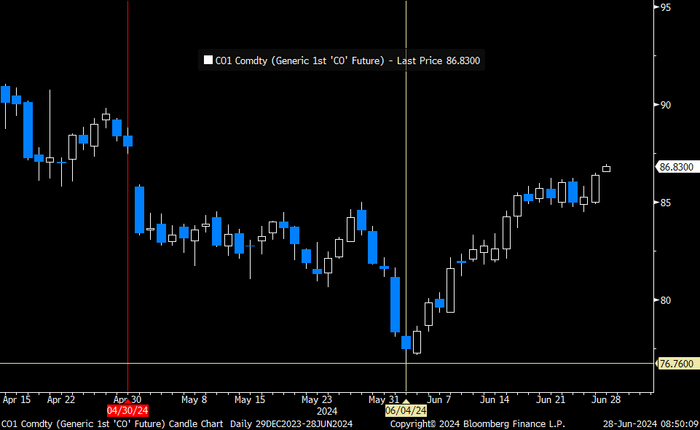
The rally in Brent crude since early June is counter to rising US oil inventories and as such a bit puzzling to the market.
US commercial crude and oil product stocks excluding SPR.
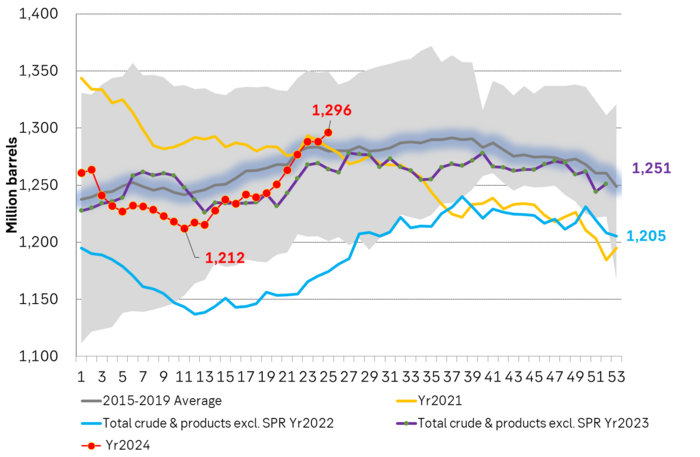
Actual US crude oil production data for April will be published later today. Zero growth in April is likely. Later today the US EIA will publish actual production data for US crude and liquids production for April. Estimates based on US DPR and DUC data indicates that there will indeed be zero growth in US crude oil production MoM in April. This will likely driving home the message that there is no growth in US crude oil production despite a Brent crude oil price of USD 83/b over the past 12 mths. The extension of this is of course rising expectations that there will be no growth in US crude oil production for the coming 12 months either as long as Brent crude hoovers around USD 85/b.
US production breaking a pattern since Jan 2014. No growth at USD 83/b. What stands out when graphing crude oil prices versus growth/decline in US crude oil production is that since January 2014 we have not seen a single month that US crude oil production is steady state or declining when the Brent crude oil price has been averaging USD 70.5/b or higher.
US Senate looking into the possibility that US shale oil producers are now colluding by holding back on investments, thus helping to keep prices leveled around USD 85/b.
Brent crude 12mth rolling average price vs 4mth/4mth change in US crude oil production. Scatter plot of data starting Jan 2014. Large red dot is if there is no change in US crude oil production from March to April. Orange dots are data since Jan 2023. The dot with ”-1.3%” is the March data point.
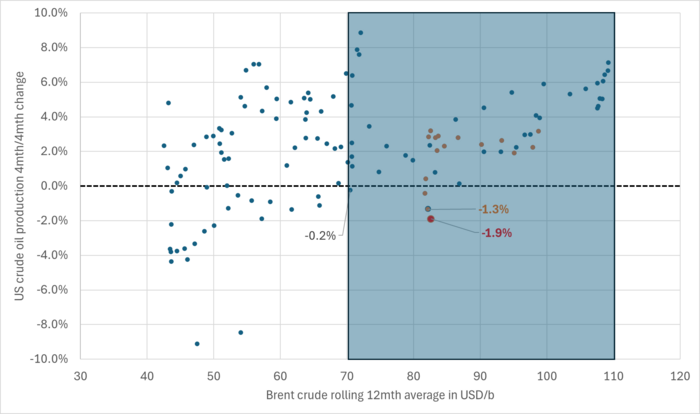
Brent crude 12mth rolling average price vs 4mth/4mth change in US crude oil production. Data starting Jan 2014. The last data point is if there is no change in US crude oil production from March to April.
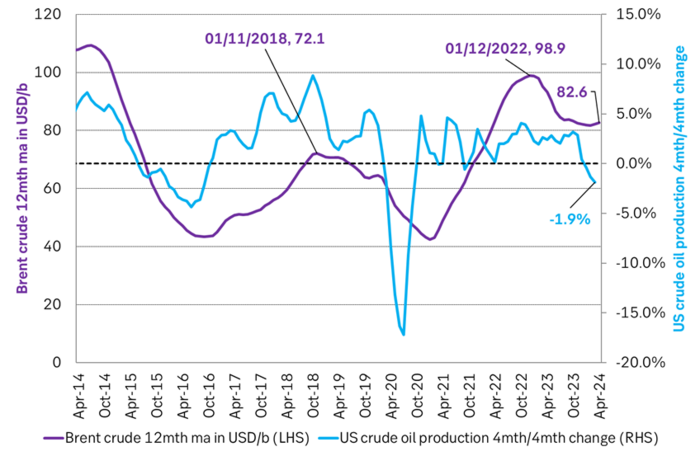
Analys
Price forecast update: Weaker green forces in the EU Parliament implies softer EUA prices


We reduce our forecast for EUA prices to 2030 by 10% to reflect the weakened green political agenda in the EU Parliament following the election for the Parliament on 6-9 June. The upcoming election in France on 7 July is an additional risk to the political stability of EU and thus in part also to the solidity of the blocks green agenda. Environmental targets for 2035 and 2040 are most at risk of being weakened on the margin. EUA prices for the coming years to 2030 relate to post-2030 EUA prices through the bankability mechanism. Lower post-2030 climate ambitions and lower post-2030 EUA prices thus have a bearish impact on EUA prices running up to 2030. Actual softening of post-2030 climate ambitions by the EU Parliament have yet to materialize. But when/if they do, a more specific analysis for the consequences for prices can be carried out.
EUA prices broke with its relationship with nat gas prices following the EU Parliament election. The EUA price has dutifully followed the TTF nat gas price higher since they both bottomed out on 23 Feb this year. The EUA front-month price bottomed out with a closing price of EUR 50.63/ton on 23 Feb. It then reached a recent peak of EUR 74.66/ton on 21 May as nat gas prices spiked. Strong relationship between EUA prices and nat gas prices all the way. Then came the EU Parliament election on 6-9 June. Since then the EUA price and TTF nat gas prices have started to depart. Bullish nat gas prices are no longer a simple predictor for bullish EUA prices.
The front-month EUA price vs the front-year TTF nat gas price. Hand in hand until the latest EU Parliament election. Then departing.
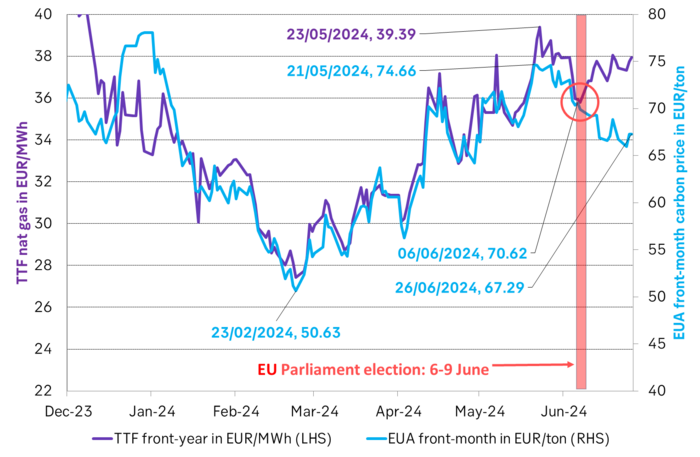
The EU Parliament election on 6-9 June was a big backlash for the Greens. The Greens experienced an euphoric victory in the 2019 election when they moved from 52 seats to 74 seats in the Parliament. Since then we have had an energy crisis with astronomic power and nat gas prices, rampant inflation and angry consumers being hurt by it all. In the recent election the Greens in the EU Parliament fell back to 53 seats. Close to where they were before 2019.
While green politics and CO2 prices may have gotten a lot of blame for the pain from energy prices over the latest 2-3 years, the explosion in nat gas prices are largely to blame. But German green policies to replace gas and oil heaters with heat pumps and new environmental regulations for EU farmers are also to blame for the recent pullback in green seats in the Parliament.
Green deal is still alive, but it may not be fully kicking any more. Existing Green laws may be hard to undo, but targets for 2035 and 2040 will be decided upon over the coming five years and will likely be weakened.
At heart the EU ETS system is a political system. As such the EUA price is a politically set price. It rests on the political consensus for environmental priorities on aggregate in EU.
The changes to the EU Parliament will likely weaken post-2030 environmental targets. The changes to the EU Parliament may not change the supply/demand balance for EUAs from now to 2030. But it will likely weaken post-2030 environmental targets and and thus projected EU ETS balances and EUA prices post-2030. And through the bankability mechanism this will necessarily impact EUA prices for the years from now to 2030.
Weaker post-2030 ambitions, targets and prices implies weaker EUA prices to 2030. EUA prices are ”bankable”. You can buy them today and hold on to them and sell them in 2030 or 2035. The value of an EUA today fundamentally rests on expected EUA prices for 2030/35. These again depends on EU green policies for the post 2030 period. Much of these policies will be ironed out and decided over the coming five years.
Weakening of post-2030 targets have yet to materialize. But just talking about it is a cold shower for EUAs. These likely coming weakenings in post-2030 environmental targets and how they will impact EUA prices post 2030 and thus EUA prices from now to 2030 are hard to quantify. But what is clear to say is that when politicians shift their priorities away from the environment and reduce their ambitions for environmental targets post-2030 it’s like a cold shower for EUA prices already today.
On top of this we now also have snap elections in the UK on 4 July and in France on 7 July with the latter having the potential to ”trigger the next euro crisis” according to Gideon Rachman in a recent article in FT.
What’s to be considered a fair outlook for EUA prices for the coming five years in this new political landscape with fundamentally changed political priorities remains to be settled. But that EUA price outlooks will be lowered versus previous forecasts is almost certain.
We reduce our EUA price forecast to 2030 by 10% to reflect the new political realities. To start with we reduce our EUA price outlook by 10% from 2025 to 2030 to reflect the weakened Green agenda in the EU parliament.
SEB’s EUA price forecast, BNEF price forecasts and current market prices in EUR/MWh
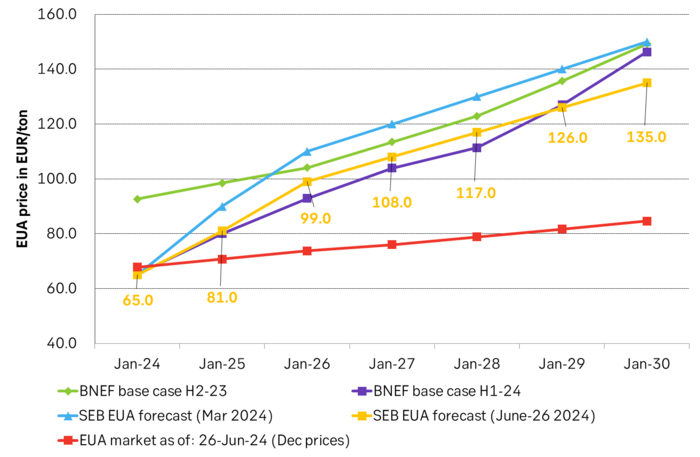
Analys
The most important data point in the global oil market will be published on Friday 28 June


US crude oil production has been booming for more than a decade. Interrupted by two setbacks in response to sharp price declines. The US boom has created large waves in the global oil market and made life very difficult for OPEC(+). Brent crude has not traded below USD 70/b since Dec-2021 and over the past year, it has averaged USD 84/b. US shale oil production would typically boom with such a price level historically. However, there has been zero growth in US crude oil production from Sep-2023 to Mar-2024. This may be partially due to a cold US winter, but something fundamentally seems to have changed. We recently visited a range of US E&P and oil services companies in Houston. The general view was that there would be zero growth in US crude oil production YoY to May 2025. If so and if it also is a general shift to sideways US crude oil production beyond that point, it will be a tremendous shift for the global oil market. It will massively improve the position of OPEC+. It will also sharply change our perception of the forever booming US shale oil supply. But ”the proof is in the pudding” and that is data. More specifically the US monthly, controlled oil production data is to be published on Friday 28 June.
The most important data point in the global oil market will be published on Friday 28 June. The US EIA will then publish its monthly revised and controlled oil production data for April. Following years of booming growth, the US crude oil production has now gone sideways from September 2023 to March 2024. Is this a temporary blip in the growth curve due to a hard and cold US winter or is it the early signs of a huge, fundamental shift where US crude oil production moves from a decade of booming growth to flat-lining horizontal production?
We recently visited a range of E&P and oil services companies in Houston. The general view there was that US crude oil production will be no higher in May 2025 than it is in May 2024. I.e. zero growth.
It may sound undramatic, but if it plays out it is a huge change for the global oil market. It will significantly strengthen the position of OPEC+ and its ability to steer the oil price to a suitable level of its choosing.
The data point on Friday will tell us more about whether the companies we met are correct in their assessment of non-growth in the coming 12 months or whether production growth will accelerate yet again following a slowdown during winter.
The US releases weekly estimates for its crude oil production but these are rough, temporary estimates. The market was fooled by these weekly numbers last year when the weekly numbers pointed to a steady production of around 12.2 m b/d from March to July while actual monthly data, with a substantial lag in publishing, showed that production was rising strongly.
The real data are the monthly, controlled data. These data will be the ”proof of the pudding” of whether US shale oil production now is about to shift from a decade of booming growth to instead flat-line sideways or whether it will drift gradually higher as projected by the US EIA in its latest Short-Term Energy Outlook.
US crude oil production given by weekly data and monthly data. Note that the monthly, controlled data comes with a significant lag. The market was thus navigating along the weekly data which showed ”sideways at 12.2 m b/d” for a significant period last year until actual data showed otherwise with a time-lag.
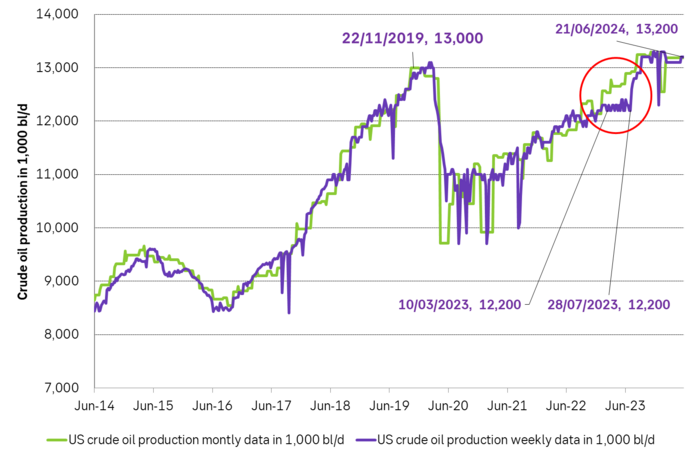
If we add in Natural Gas Liquids and zoom out to include history back to 2001 we see an almost uninterrupted boom in supply since Sep 2011 with a few setbacks. At first glance, this graph gives little support to a belief that US crude oil production now suddenly will go sideways. Simple extrapolation of the graph indicates growth, growth, growth.
US crude and liquids production has boomed since September 2011
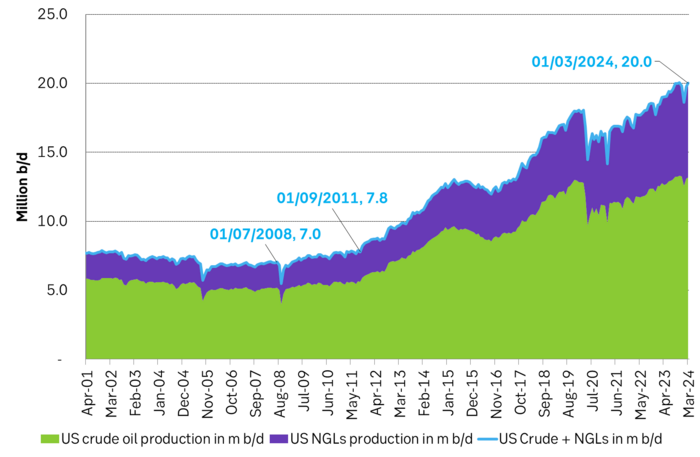
However. The latest actual data point for US crude oil production is for March with a reading of 13.18 m b/d. What stands out is that production then was still below the September level of 13.25 m b/d.
The world has gotten used to forever growing US crude oil production due to the US shale oil revolution, with shorter periods of sharp production declines as a result of sharp price declines.
But the Brent crude oil price hasn’t collapsed. Instead, it is trading solidly in the range of USD 70-80-90/b. The front-month Brent crude oil contract hasn’t closed below USD 70/b since December 2021.
Experiences from the last 15 years would imply wild production growth and activity in US shale oil production at current crude oil prices. But US crude oil production has now basically gone sideways to lower from September to March.
The big, big question is thus: Are we now witnessing the early innings of a big change in US shale oil production where we shift from booming growth to flat-lining of production?
If we zoom in we can see that US liquids production has flat-lined since September 2023. Is the flat-lining from Sep to Mar due to the cold winter so that we’ll see a revival into spring and summer or are we witnessing the early signs of a huge change in the global oil market where US crude oil production goes from booming growth to flat-line production.

The message from Houston was that there will be no growth in US crude oil production until May 2025. SEB recently visited oil and gas producers and services providers in Houston to take the pulse of the oil and gas business. Especially so the US shale oil and shale gas business. What we found was an unusually homogeneous view among the companies we met concerning both the state of the situation and the outlook. The sentiment was kind of peculiar. Everybody was making money and was kind of happy about that, but there was no enthusiasm as the growth and boom years were gone. The unanimous view was that US crude oil production would be no higher one year from now than it is today. I.e. flat-lining from here.
The arguments for flat-lining of US crude oil production here onward were many.
1) The shale oil business has ”grown up” and matured with a focus on profits rather than growth for the sake of growth.
2) Bankruptcies and M&As have consolidated the shale oil companies into larger, fewer public companies now accounting for up to 75% of total production. Investors in these companies have little interest/appetite for growth after having burned their fingers during a decade and a half of capital destruction. These investors may also be skeptical of the longevity of the US shale oil business. Better to fully utilize the current shale oil infrastructure steadily over the coming years and return profits to shareholders than to invest in yet more infrastructure capacity and growth.
3) The remaining 25% of shale oil producers which are in private hands have limited scope for growth as they lack pipeline capacity for bringing more crude oil from field to market. Associated nat gas production is also a problem/bottleneck as flaring is forbidden in many places and pipes to transport nat gas from field to market are limited.
4) The low-hanging fruits of volume productivity have been harvested. Drilling and fracking are now mostly running 24/7 and most new wells today are all ”long wells” of around 3 miles. So hard to shave off yet another day in terms of ”drilling yet faster” and the length of the wells has increasingly reached their natural optimal length.
5) The average ”rock quality” of wells drilled in the US in 2024 will be of slightly lower quality than in 2023 and 2025 will be slightly lower quality than 2024. That is not to say that the US, or more specifically the Permian basin, is quickly running out of shale oil resources. But this will be a slight headwind. There is also an increasing insight into the fact that US shale oil resources are indeed finite and that it is now time to harvest values over the coming 5-10 years. One company we met in Houston argued that US shale oil production would now move sideways for 6-7 years and then overall production decline would set in.
The US shale oil revolution can be divided into three main phases. Each phase is probably equally revolutionary as the other in terms of impact on the global oil market.
1) The boom phase. It started after 2008 but didn’t accelerate in force before the ”Arab Spring” erupted and drove the oil price to USD 110/b from 2011 to 2014. It was talked down time and time again, but it continued to boom and re-boom to the point that today it is almost impossible to envision that it won’t just continue to boom or at least grow forever.
2) The plateau phase. The low-hanging fruits of productivity growth have been harvested. The highest quality resources have been utilized. The halfway point of resources has been extracted. Consolidation, normalization, and maturity of the business has been reached. Production goes sideways.
3) The decline phase. Eventually, the resources will have been extracted to the point that production unavoidably starts to decline.
Moving from phase one to phase two may be almost as shocking for the oil market as the experience of phase 1. The discussions we had with oil producers and services companies in Houston may indicate that we may now be moving from phase one to phase two. That there will be zero shale oil production growth YoY in 2025 and that production then may go sideways for 6-7 years before phase three sets in.
US EIA June STEO report with EIA’s projection for US crude oil production to Dec-2025. Softer growth, but still growth.
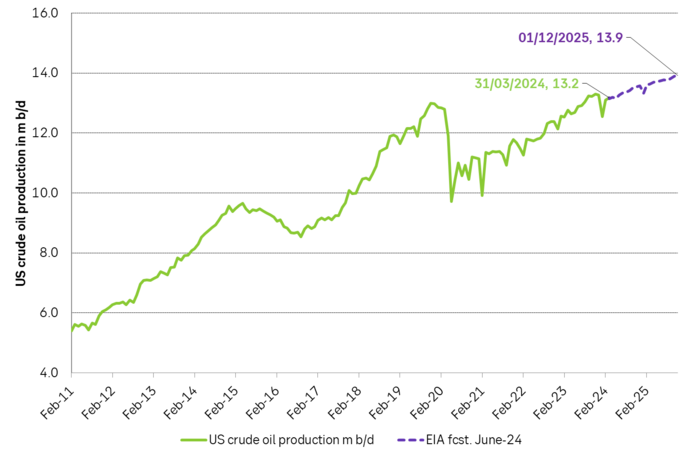
US EIA June STEO report with YoY outlook growth for 2025. Projects that US crude production will grow by 0.47 m b/d YoY in 2025 and that total liquids will grow by 720 k b/d YoY.
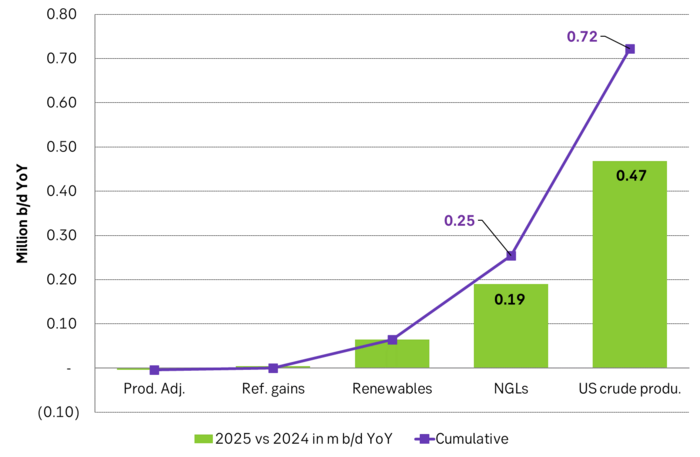
US EIA June STEO report with outlook for production growth by country in 2025. This shows how big the US production growth of 0.7 m b/d YoY really is compared to other producers around the world
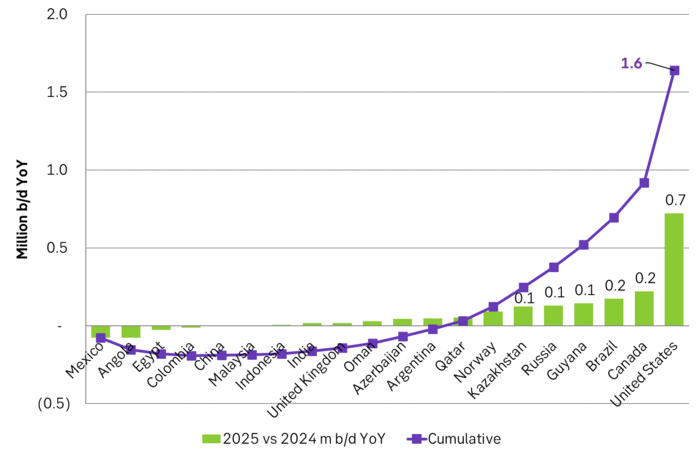
US EIA June STEO report with projected global growth in supply and demand YoY in 2025. Solid demand growth, but even strong supply growth with little room for OPEC+ to expand. Production growth by non-OPEC+ will basically cover global oil demand growth.
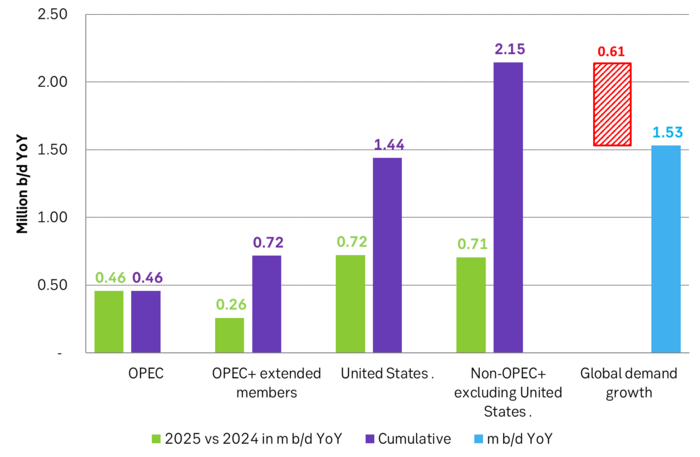
But if there instead is zero growth in US crude oil production in 2025 and the US liquids production only grows by 0.25 m b/d YoY due to NGLs and biofuels, then suddenly there is room for OPEC+ to put some of its current production cuts back into the market. Thus growth/no-growth in US shale oil production will be of huge importance for OPEC+ in 2025. If there is no growth in US shale oil then OPEC+ will have a much better position to control the oil price to where it wants it.
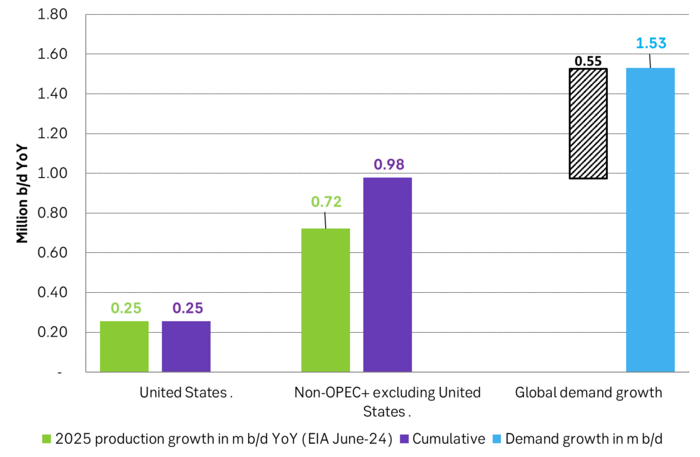
US crude oil production and drilling rig count
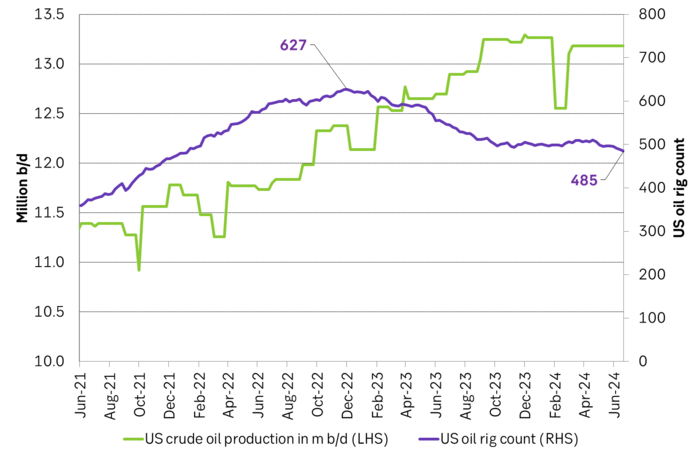
-

 Nyheter1 vecka sedan
Nyheter1 vecka sedanDe tre bästa råvaruvaruaktierna just nu
-

 Nyheter2 veckor sedan
Nyheter2 veckor sedanLundin Mining vill köpa Filo Corp tillsammans med BHP
-

 Nyheter4 veckor sedan
Nyheter4 veckor sedanAfrica Oil är bra att köpa anser Stifel som inleder analysbevakning
-
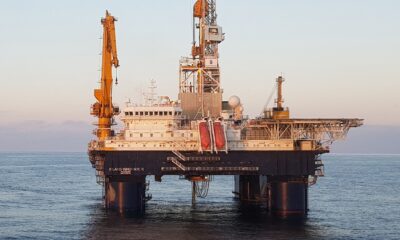
 Nyheter3 veckor sedan
Nyheter3 veckor sedanStor risk att Africa Energy inte överlever det kommande året
-

 Nyheter4 veckor sedan
Nyheter4 veckor sedanFirst Nordic Metals har fyra prospekteringsprojekt i Sverige
-

 Analys4 veckor sedan
Analys4 veckor sedanBrent crude inching higher on optimism that US inflationary pressures are fading
-

 Nyheter2 veckor sedan
Nyheter2 veckor sedanUniper satsar på att göra elektrobränsle av sin elektricitet
-

 Nyheter2 veckor sedan
Nyheter2 veckor sedanTre bra aktier inom olja och oljeservice i Kanada


